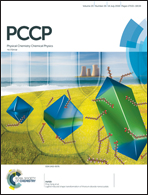Bicycloaromaticity and Baird-type bicycloaromaticity of dithienothiophene-bridged [34]octaphyrins†
Abstract
Aromatic properties of two recently synthesized dithienothiophene-bridged (DTT) [34]octaphyrins have been investigated by calculating magnetically induced current densities and vertical excitation energies. These intriguing molecules have been proposed to be the first synthesized neutral bicycloaromatic compounds. The triplet state of their dications was even suggested to be Baird-type bicycloaromatic rendering them very interesting as a new prototype of molecules possessing simultaneously the two rare types of aromaticity. Here, we investigate computationally the aromatic properties of the neutral as well as the singly and doubly charged DTT-bridged [34]octaphyrins. Our study provides unambiguous information about changes in the aromatic properties of the DTT-bridged [34]octaphyrins upon oxidation. The calculations identify two independent diatropic ring currents in the neutral DTT-bridged [34]octaphyrins, showing that they are indeed bicycloaromatic. The current-density flow of the two independent ring currents of the bicycloaromatic compounds are visualized and individual aromatic pathways are quantified by performing numerical integration. The calculations show that two independent diatropic ring currents can indeed be sustained by molecules consisting of two aromatic rings that share a common set of π electrons. The current density calculations on the singly charged DTT-bridged [34]octaphyrins show that they are weakly antiaromatic, which does not agree with the suggested aromatic character deduced from spectroscopical studies. The triplet state of the two DTT-bridged [34]octaphyrin cations with very similar molecular structures have unexpectedly different aromatic character. One of them is Baird-type bicycloaromatic, whereas the triplet state of the other dication has one aromatic and one nonaromatic ring, which could not be resolved from available spectroscopical data. Calculations of excitation energies reveal that a simple model cannot be employed for interpreting the electronic excitation spectra of the present molecules, because more than 20 excited states contribute to the spectra above 2.5 eV (500 nm) showing the importance of computations. The present work illustrates how detailed information about molecular aromaticity can nowadays be obtained by scrutinizing calculated current densities.
![Graphical abstract: Bicycloaromaticity and Baird-type bicycloaromaticity of dithienothiophene-bridged [34]octaphyrins](/en/Image/Get?imageInfo.ImageType=GA&imageInfo.ImageIdentifier.ManuscriptID=C8CP03112F&imageInfo.ImageIdentifier.Year=2018)
- This article is part of the themed collection: 2018 PCCP HOT Articles


 Please wait while we load your content...
Please wait while we load your content...